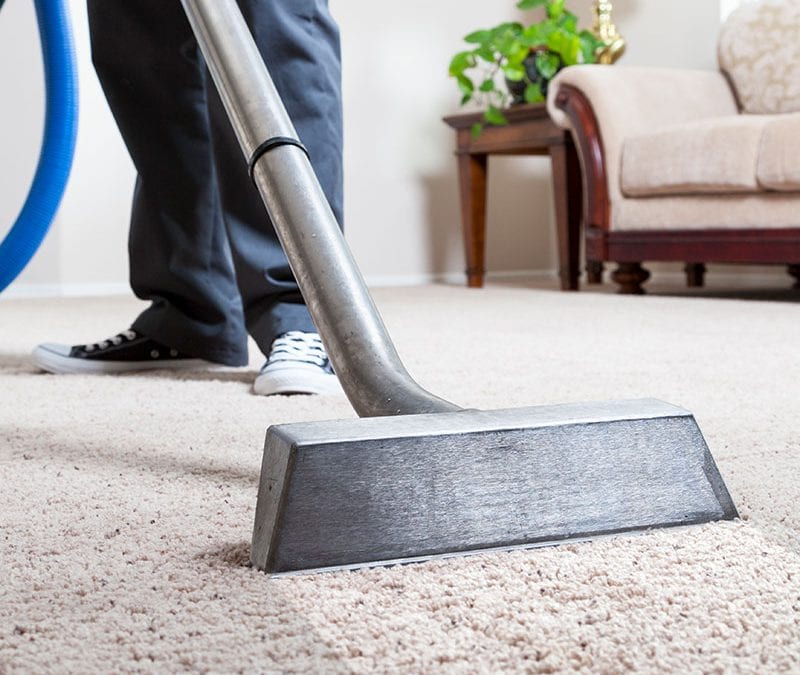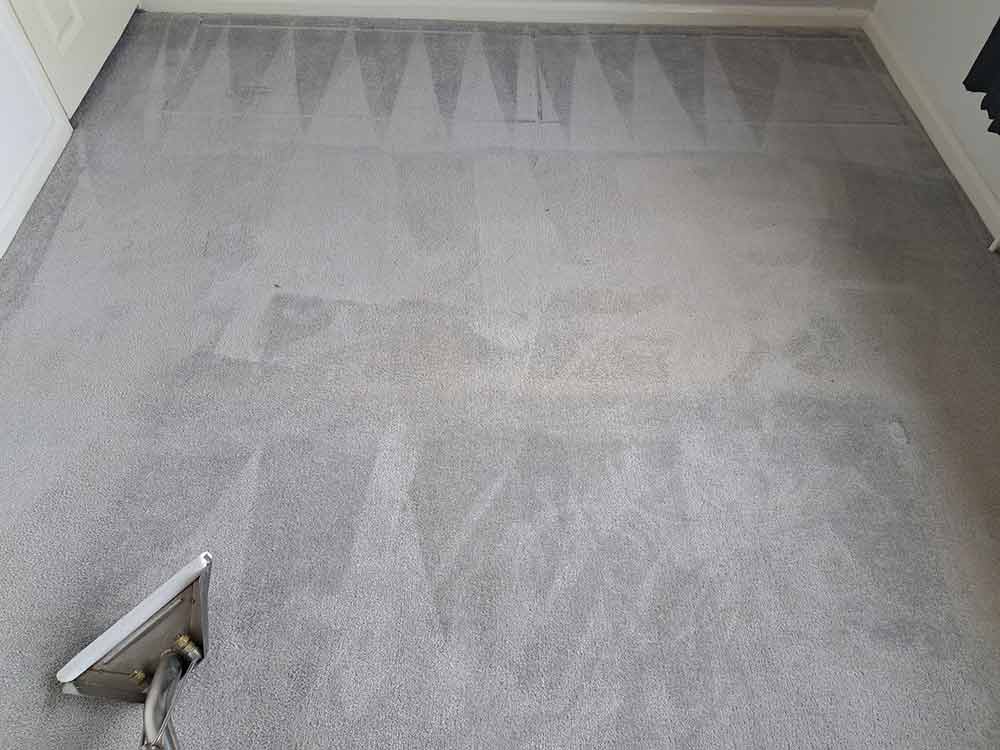To get rid of bad smells from your carpet, start by identifying the source, which could be pet accidents, food spills, or mould. Once you’ve pinpointed the problem area, treat it with a diluted vinegar solution (one part vinegar to three parts water), ensuring you first test this on a hidden section of your carpet. For a natural, fragrance-enhancing option, add a few drops of essential oils like lavender or eucalyptus to the mix. Alternatively, sprinkle baking soda generously over the carpet, let it sit overnight, and vacuum thoroughly the next day. These methods not only remove odours but also maintain your carpet’s freshness. With consistent care, you’ll notice a significant improvement in both smell and appearance.
Identifying the Source of Odours
To effectively remove bad smells from your carpet, first pinpoint the exact origin of the odour. Understanding the various odour types and mastering source identification are vital in tackling this issue head-on.
You’ll find that odours generally fall into a few categories: pet accidents, food and drink spills, or mold and mildew growth.
First, inspect visually. Look for any obvious stains or spots that suggest a spill or accident. Sometimes, the location of the smell will guide you right to the source. If the odour persists without visible signs, you might need to get down closer to the carpet and sniff along to locate the more subtle sources.
Next, consider the room’s usage. Rooms with high foot traffic or those frequented by pets are more likely to harbor lingering smells. Identifying the common activities in each area can help you deduce potential culprits.
Don’t overlook the possibility of moisture being the perpetrator. Wet patches can sometimes go unnoticed, especially under furniture or in corners. These areas can foster mold and mildew, which contribute greatly to unpleasant carpet odours.
With a keen sense of observation and a systematic approach, you’ll be well on your way to a fresher, cleaner-smelling carpet.
Natural Deodourising Solutions
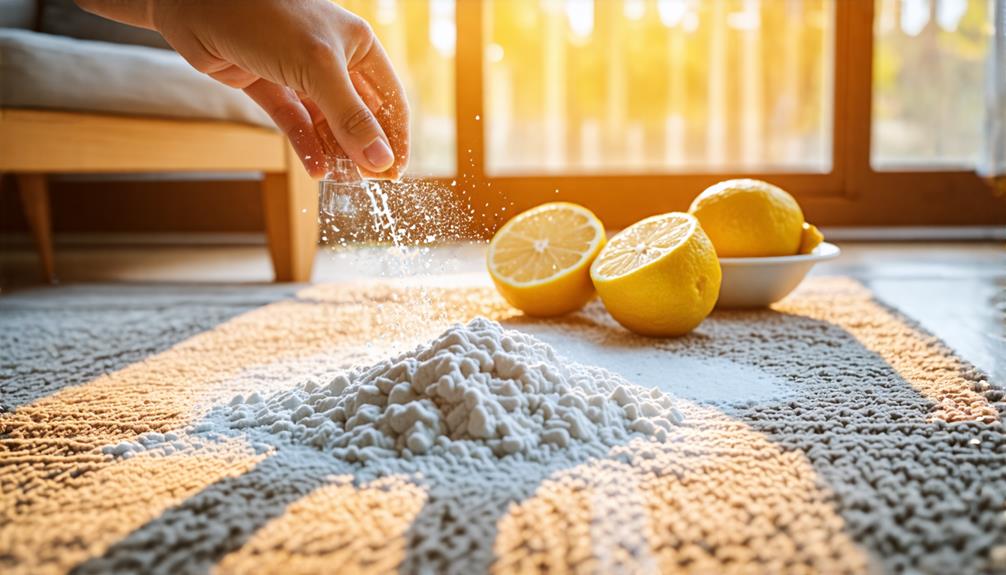
Once you’ve identified the source of the carpet odour, you can use several natural deodourising solutions to effectively neutralise and remove the smell. Among the most effective are vinegar solutions and essential oils, both renowned for their natural deodourising properties.
To start, you’ll want to create a diluted vinegar solution. Mix one part white vinegar with three parts water in a spray bottle. Test this mixture on a small, inconspicuous area of your carpet to verify it doesn’t affect the color or texture. Once you’ve confirmed it’s safe, lightly spray the affected area. Let it sit for 10-15 minutes, then blot dry with a clean cloth. The acidic nature of vinegar helps to break down odour-causing molecules, leaving your carpet fresh.
For a more fragrant approach, adding essential oils to your cleaning regimen can be highly beneficial. Select oils like lavender, eucalyptus, or tea tree for their strong antibacterial and odour-neutralising capabilities. Add a few drops of your chosen essential oil to the vinegar solution before spraying.
This not only tackles the bad odours but also imparts a pleasant, lasting fragrance to your carpet, enhancing the overall freshness of your room.
Using Baking Soda Effectively
Sprinkling baking soda generously over your carpet can effectively absorb and neutralise unpleasant odours. This simple method is one of the most accessible and affordable baking soda applications, leveraging its natural odour absorption techniques.
Here’s how to do it right:
- Apply Liberally: Don’t skimp on the amount of baking soda you use. Cover the entire carpet area with a thin, even layer. This guarantees maximum contact with odour particles, improving absorption efficiency.
- Let It Sit: Once applied, let the baking soda sit on the carpet for several hours, ideally overnight. The longer it sits, the more time it has to neutralise odours. This waiting period allows the baking soda to penetrate deeper into the fibres, tackling odours right at their source.
- Vacuum Thoroughly: After the baking soda has had time to work its magic, vacuum your carpet thoroughly to remove all the powder. Make sure to go over each area multiple times to guarantee no residue is left behind, which could otherwise attract more dirt.
Professional Cleaning Options
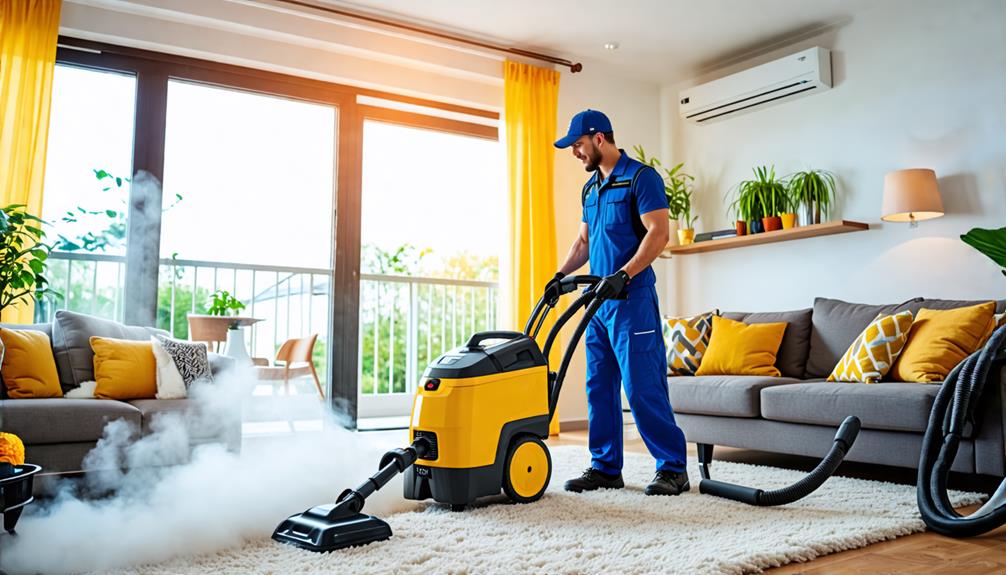
If home remedies like baking soda don’t fully eliminate odours, consider hiring a professional carpet cleaning service to tackle deep-seated smells. These experts have access to powerful tools and specialised techniques that go beyond what you can achieve with typical DIY methods.
One effective professional method is steam cleaning. This process injects hot water and cleaning agents deep into your carpet fibres, then extracts them along with the trapped odours. The high temperature of the steam also helps to kill bacteria that may be contributing to the unpleasant smells. It’s vital, however, to make certain the carpet dries thoroughly afterward to prevent mould growth.
Another option you might explore is the use of enzyme cleaners. These are particularly adept at breaking down organic matter such as pet urine, food spills, and bodily fluids, which are common sources of carpet odours. Enzyme cleaners work by catalysing the breakdown of these substances into non-odourous compounds. Most professional carpet cleaners can apply these treatments as part of their service.
Opting for a professional cleaning not only guarantees a deeper clean but also extends the life of your carpet by removing debris that can wear down fibers over time. When you choose a reputable service, you’ll notice a significant improvement in both cleanliness and air quality.
Preventing Future Odours
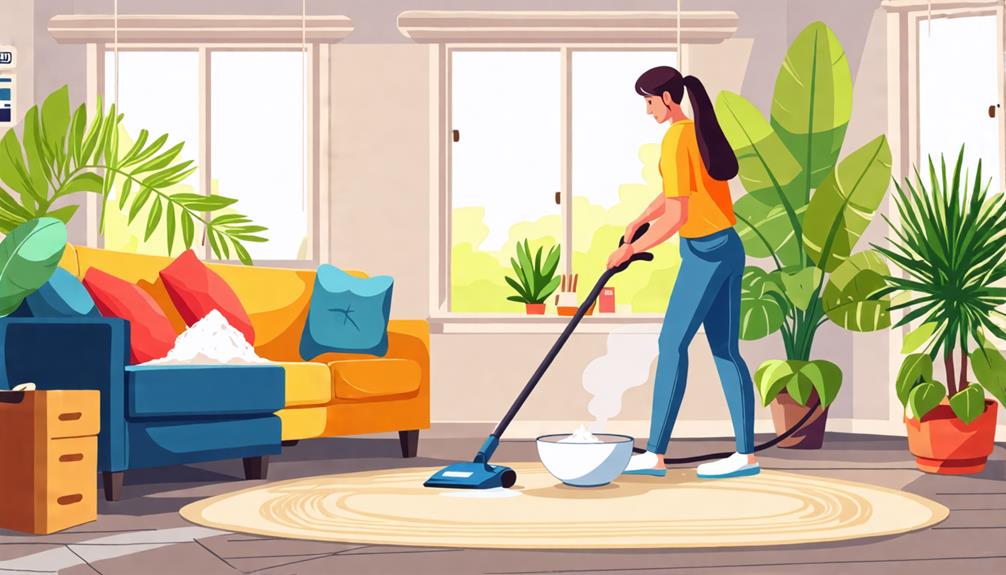
Having addressed how professional cleaning can effectively remove existing odours, it’s equally important to implement strategies to prevent these smells from returning to your carpet. Here are three practical odour prevention strategies and carpet maintenance tips to help you maintain a fresh and clean carpet:
- Regular Vacuuming: It’s essential to vacuum your carpet at least twice a week, or more often in high-traffic areas. This removes dirt, pet hair, and other debris that can contribute to odours over time. Use a vacuum with a HEPA filter for the best results, as it can trap even the smallest particles.
- Immediate Spill Response: Act quickly when spills occur. Blot the spill with a clean, dry cloth to absorb as much liquid as possible, then clean the area with a mild detergent or a carpet cleaner designed for your specific type of carpet. Avoid rubbing the spill, as this can push the liquid deeper into the fibers.
- Use Baking Soda: For a natural odour absorber, lightly sprinkle baking soda on your carpet every few weeks. Let it sit for several hours or overnight, then vacuum it up. This can help neutralise odours without the use of harsh chemicals.
Implementing these tips consistently will help you keep your carpet fresh and odour-free.

